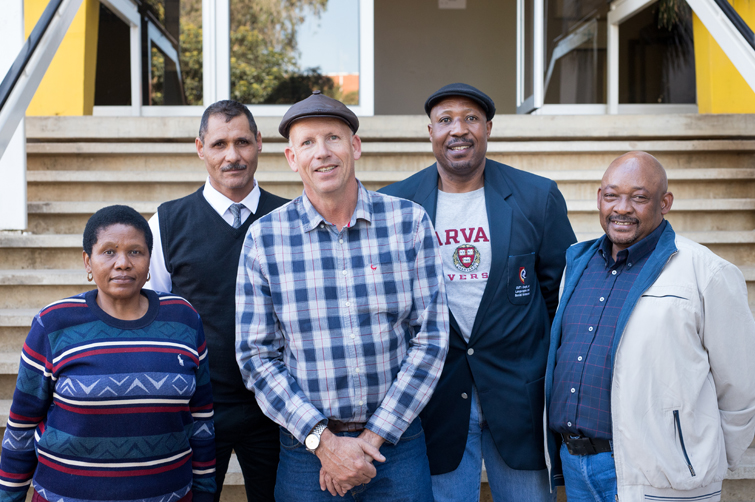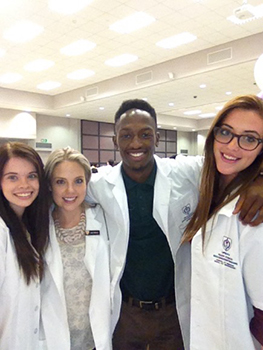Latest News Archive
Please select Category, Year, and then Month to display items
13 January 2020
|
Story Eugene Seegers
|
Photo Anja Aucamp
 Spearheading the digital expansion of the conversational Sesotho course is IDEAS Lab Director, Johann Möller (middle). With him are from the left: Prof Pule Phindane, CUT; Dr Brenton Fredericks, CUT; Bahedile Letlala, UFS Department of African Languages; and Dr Elias Malete, UFS Department of African Languages.
Spearheading the digital expansion of the conversational Sesotho course is IDEAS Lab Director, Johann Möller (middle). With him are from the left: Prof Pule Phindane, CUT; Dr Brenton Fredericks, CUT; Bahedile Letlala, UFS Department of African Languages; and Dr Elias Malete, UFS Department of African Languages.
For many years now, the UFS has been offering a one-year course in conversational Sesotho for staff members; this can then be followed up with the one-year course in advanced conversational Sesotho. The conversational Sesotho for students in the Faculty of Education was introduced in 2018 at the UFS.
The Central University of Technology (CUT) needed a conversational course for its first-year students and approached the Department of African Languages for the development of such a course. Living as we do in a multilingual country; this additional language skill opens doors and often hearts as well.
Using instructional design principles
However, the need was identified by both CUT and UFS to present this crucial information in a way that would be more appealing to digital natives as well as to those less familiar with technology. The Department of African Languages on the UFS Bloemfontein Campus, together with relevant departments from the CUT, approached the IDEAS Lab located on the UFS South Campus, since they already have a reputation for being a specialist on broadcasting and repackaging curricular content for digital presentations. The IDEAS Lab provided technical advice and built the multimedia programme, which will help the user to hear and practice phrases in Sesotho, using instructional design principles. The course will be available to both staff and students belonging to the two universities.
Room for growth
Johann Möller, Director of the IDEAS Lab, says this pilot programme will give both institutions the opportunity to test the use of multimedia for language acquisition. He adds, “Language is extremely complex, and we would like to expand this learning aid in the future.” In fact, the original design has room for growth built into it.
To keep things simple for the user and the building team, it was decided to start out with only four potential everyday scenarios where a staff member would like to speak Sesotho: Firstly, how to greet other persons from different genders; secondly, potential scenarios one might encounter in the university environment itself; thirdly, how to deal with situations at a hospital; and finally, how to use one’s language skills at a filling station.
Pronunciation is key
Each scenario contains three to four conversations that the learner can revise, along with images and audio that illustrate the situation and assist with correct pronunciation. The system does not allow the user to progress unless they have listened to the pronunciations of the sample sentences or phrases.
Further reading material and vocabulary lists are also provided, with the result that people who are using the programme can learn at their own pace. The authoring software Articulate Storyline was used to build the individual scenarios and each conversation or lesson within it. The lessons are also not dependent on an internet connection; they can be downloaded onto a flash memory drive and used offline.
School of Medicine White Coat ceremony embraces first-years into the fold
2016-03-17

From the left are first-year UFS medical students Liandri Van Zyl, Lane Halberg, Wisani Baloyi, and Neve Steenbeek at the annual White Coat ceremony, wearing their white coats for the first time. |
“Life isn’t about yourself. It’s about what you can pour into the lives of others.” The first-year medical students will not soon forget Dr Lynette van der Merwe’s words during their recent White Coat ceremony. Dr Van der Merwe is the Programme Director of the MBChB undergraduate program at the University of the Free State (UFS) School of Medicine.
The annual White Coat ceremony is a tradition at the school to welcome first-year students to the world of medicine. As an official initiation into this new world, students are allowed to put on their white coats for the first time. During the ceremony, representatives from the Medical Students Association contributed to the significance of the event by reading a declaration of intent regarding professional behaviour for all medical students.
Dr Wayne Marais, Head of the UFS Department of Ophthalmology, was the guest speaker, sharing his vivid memories of being the first black student to study Medicine at the UFS in 1987. Prof Marais encouraged students to embrace their failures and successes, and to ultimately stay true to themselves – both personally and professionally.
Second-year medical students were at hand to offer advice and support. In addition to offering encouragement, they also assured the newcomers that there is a life outside of their books as well.
The entire ceremony not only served to welcome the first-years into the fold, but also unite them in a common purpose towards helping others in future.